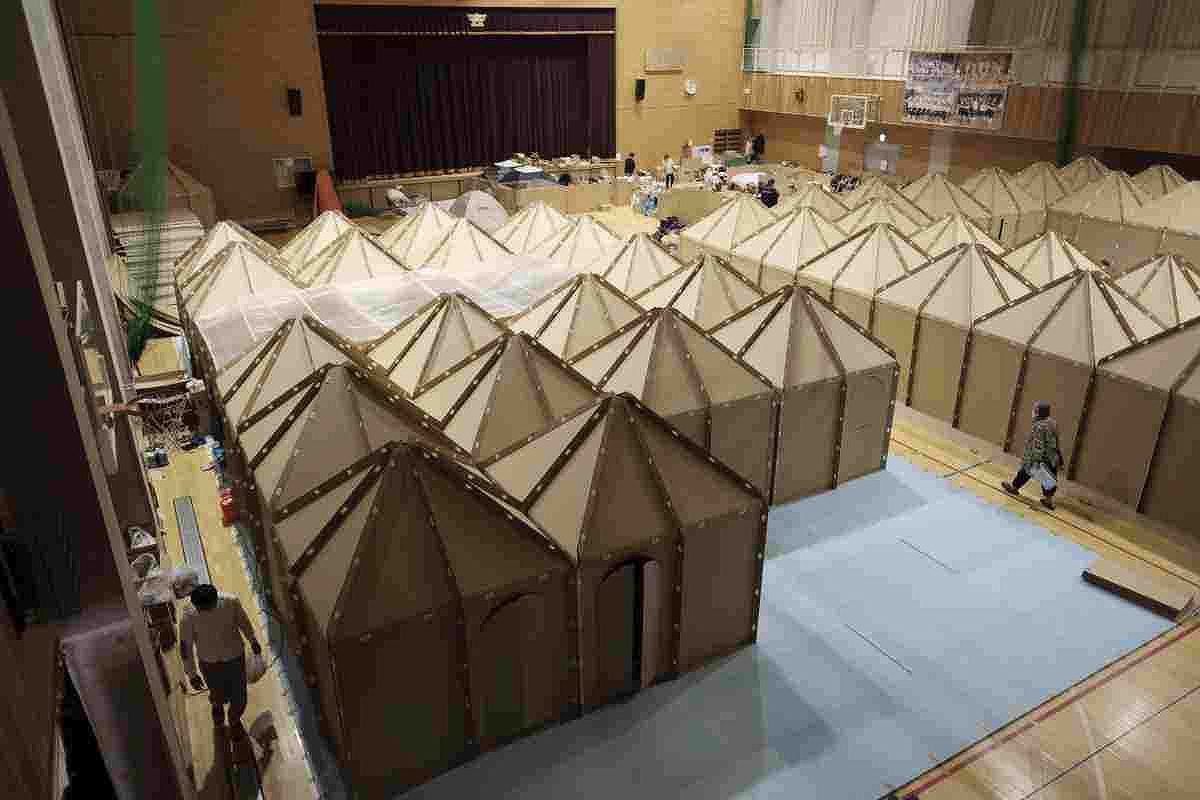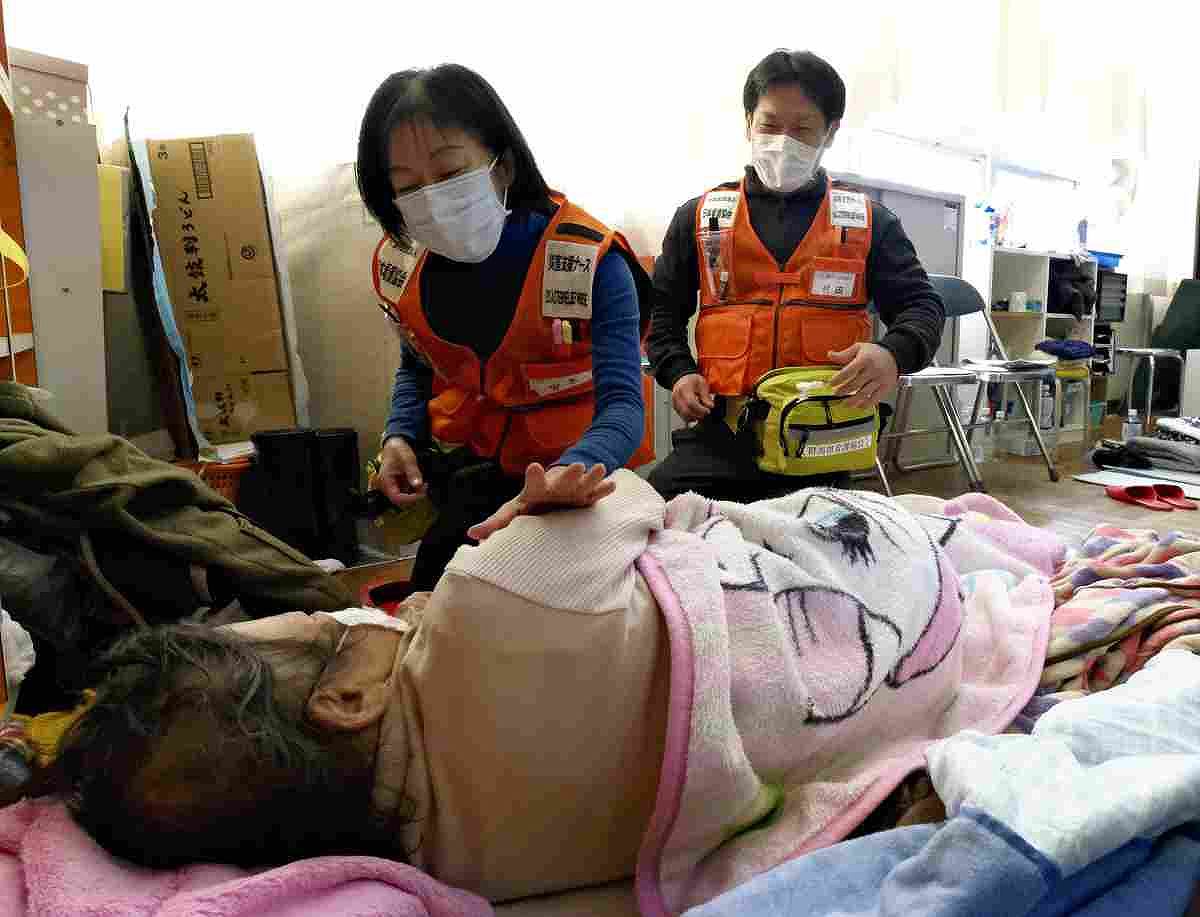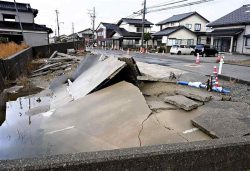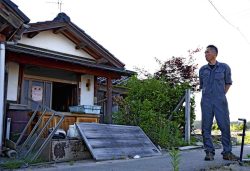Noto Quake — A Closer Look / Strain of Evacuee Life Increases ‘Disaster-Related Deaths’; Elderly People in Quake-Hit Areas at Particular Risk

Cardboard houses set up in a high school gymnasium which serves as an evacuation center in Wajima, Ishikawa Prefecture
17:29 JST, February 2, 2024
One month has passed since the deadly Jan. 1 Noto Peninsula Earthquake. This is the second installment of a series examining issues that have emerged in the disaster-stricken areas.
***
Yukiko Ikebata, 76, spent the night of Jan. 1 crammed into a minivan with six other members of her family after that day’s Noto Peninsula Earthquake, which registered maximum 7 on the Japanese seismic intensity scale, damaged or destroyed more than 2,000 houses in Wajima, Ishikawa Prefecture, where she lived.
Early the following morning, Ikebata seemed to be her usual self and chatted with her neighbors. But before long, her condition changed. Ikebata, who suffered from chronic high blood pressure, complained of chest pains. Her face had turned pale.
Ikebata’s 46-year-old second son, Shinobu, desperately looked for her medication, but he was unable to find it. Shinobu called the 119 emergency telephone number but was told that nobody could come to check on his mother “for a while.”
Shinobu drove his mother to a local hospital. He had to drive slowly because the earthquake had cracked the roads in many places.
They arrived at the hospital at 11 a.m. on Jan 2. Ikebata underwent a medical check and was told that her aorta had “started to rupture.” The hospital requested that a Doctor-Heli air ambulance be sent to take Ikebata to receive treatment, but her condition rapidly worsened around noon and she died soon after 1 p.m.
“She was always smiling and laughing,” Shinobu said of his mother. “She really was an energetic person, so it’s hard to believe that she died so quickly.”
Shinobu intends to file an application with the Wajima city government to have his mother’s death recognized as a “disaster-related death.” A disaster-related death is a death not caused directly by a disaster — such as in a tsunami or a quake-triggered building collapse — but rather one caused by stress, fatigue or the worsening of a chronic disease while staying in a shelter or vehicle after a disaster. The cases of more than 3,700 people who died after evacuating due to the March 2011 Great East Japan Earthquake have been officially recognized as disaster-related deaths. A city, town or village government may certify a disaster-related fatality after a review committee examines the case.
The stress that accompanies suddenly being forced to live in a different environment can exacerbate elderly people’s long-term health problems. For people with high blood pressure, this stress could even lead to life-threatening heart and vascular trouble. Heart and other diseases can take a sudden change for the worse as early as the day a disaster occurs.
Many elderly people in Noto
Residents of an elderly care facility in Wajima were moved to a nearby evacuation shelter on Jan. 4. The wrecked roads were impassable by car, so one bed-ridden dementia patient in her 90s was instead carried on a stretcher as rain fell that day.
The woman’s body was cold when she arrived at the shelter. A staffer frantically tried using disposable heat packs to warm her up, but the woman’s health continued to decline and she died on Jan. 6.
“I think the burden of evacuating while the weather was cold was a major reason for that,” a manager at the care facility said.
Kansai University Prof. Yoshihiro Okumura, who has analyzed disaster-related deaths from previous disasters, said elderly people were especially vulnerable.
“Disaster-related deaths tend to be higher in regions with many elderly residents,” said Okumura, an expert on comprehensive disaster prevention and mitigation. “Their risk of such a death increases further when they must live as evacuees for a prolonged period.”
People aged 65 and over account for about 50% of the population of the Okunoto area, the northern part of the Noto Peninsula. This is about 20 percentage points higher than the national average.
The stress of staying in an evacuation shelter, combined with cold conditions and nutritionally unbalanced meals, can cause the health of people with high blood pressure to worsen. Sleeping on the floor together with many others leaves people prone to breathing in dust, and the difficulty in getting enough sleep raises the risk of catching pneumonia.
“The key to preventing disaster-related deaths lies in the extent to which the living conditions of evacuees can be improved,” Okumura said.
9,000 still in shelters
According to Yasuhiro Ueshima, secretary general of the Peace Boat Disaster Relief nongovernmental organization, aid for the evacuees has been insufficient. “Compared with past disasters, relief supplies such as cardboard beds and fresh food have been slow to arrive,” Ueshima said.
The water supply is still cut off in many areas, and sanitary conditions in many evacuation centers have not improved. The government is pushing ahead with efforts to shift people from primary evacuation centers including schools and public facilities to secondary evacuation sites such as hotels and ryokan inns. However, many people are reluctant to move from their hometowns.
Fifteen people were on a list of suspected disaster-related deaths published Thursday by the Ishikawa prefectural government.
For comparison, the tally of disaster-related deaths in the aftermath of the 2016 Kumamoto earthquakes was 19 at the one-month mark, but it eventually reached 221.
Even now, about 9,000 people are still staying in primary evacuation centers in the disaster-hit Noto region.
"Society" POPULAR ARTICLE
-

M4.9 Earthquake Hits Tokyo, Neighboring Prefectures
-

Israeli Tourists Refused Accommodation at Hotel in Japan’s Nagano Pref., Prompting Protest by Israeli Embassy and Probe by Prefecture
-

M7.5 Earthquake Hits Northern Japan; Tsunami Waves Observed in Hokkaido, Aomori and Iwate Prefectures
-

Tsukiji Market Urges Tourists to Avoid Visiting in Year-End
-

M5.7 Earthquake Hits Japan’s Kumamoto Pref., Measuring Upper 5 Intensity, No Tsunami Expected
JN ACCESS RANKING
-

Tokyo Economic Security Forum to Hold Inaugural Meeting Amid Tense Global Environment
-

Keidanren Chairman Yoshinobu Tsutsui Visits Kashiwazaki-Kariwa Nuclear Power Plant; Inspects New Emergency Safety System
-

Imports of Rare Earths from China Facing Delays, May Be Caused by Deterioration of Japan-China Relations
-

University of Tokyo Professor Discusses Japanese Economic Security in Interview Ahead of Forum
-

Japan Pulls out of Vietnam Nuclear Project, Complicating Hanoi’s Power Plans

























